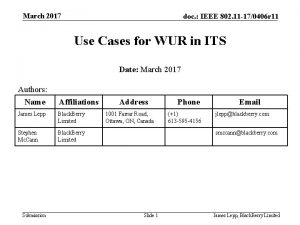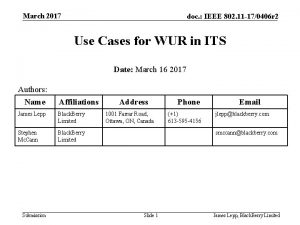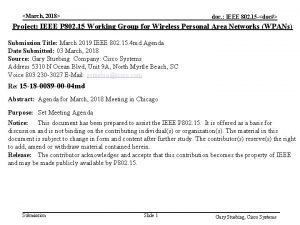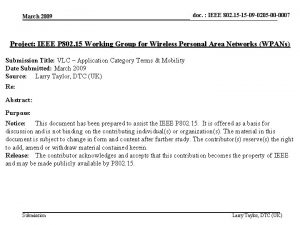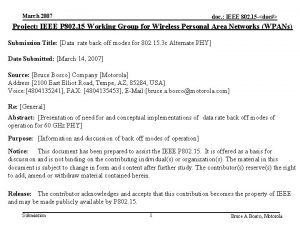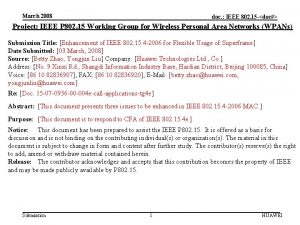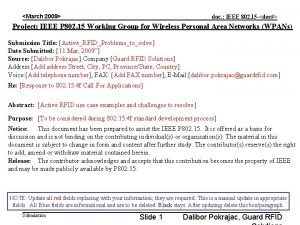March 2017 doc IEEE 802 11 170406 r










- Slides: 10

March 2017 doc. : IEEE 802. 11 -17/0406 r 3 Use Cases for WUR in ITS Date: March 16 2017 Authors: Name Affiliations James Lepp Black. Berry Limited Stephen Mc. Cann Black. Berry Limited Submission Address 1001 Farrar Road, Ottawa, ON, Canada Phone (+1) 613 -595 -4156 Email jlepp@blackberry. com smccann@blackberry. com Slide 1 James Lepp, Black. Berry Limited

March 2017 doc. : IEEE 802. 11 -17/0406 r 3 Background on 802. 11 ba (WUR) 802. 11 ba Wake-up Radio (WUR) is a low power mechanism to enable power saving in 802. 11 stations. In January 2017 it was decided to compile a Usage Model Document for 802. 11 ba. This presentation contains Usage Models for the 802. 11 ba task group to consider when designing the WUR protocol. Submission Slide 2 James Lepp, Black. Berry Limited. .

March 2017 doc. : IEEE 802. 11 -17/0406 r 3 Background on 802. 11 ITS systems 802. 11 -OCB (developed in 802. 11 p TG) is used as the basis of Intelligent Transportation Systems. Outside the context of a BSS devices transmit 802. 11 frames between vehicle onboard units (OBUs) and infrastructure roadside units (RSUs). Current 802. 11 -based ITS systems use a significant amount of energy to operate. To enable a third class of system for pedestrians and cyclists, as a group called vulnerable road users (VRUs), mechanisms to enable power saving are desired. Submission Slide 3 James Lepp, Black. Berry Limited

March 2017 doc. : IEEE 802. 11 -17/0406 r 3 Use Case 1: Wake Up Vehicle-to-Pedestrian (V 2 P) Radio • Scenario • Pedestrian carrying portable device with V 2 P capability. • To conserve power, the V 2 P mode isn’t always operating. • Roadside infrastructure such as an intersection or an oncoming vehicle sends WUR wake-up trigger frame. • Pedestrian device wakes up and operates 802. 11 -OCB based V 2 P • Wakeup operation • ITS infrastructure sends WUR wake-up trigger frame • Pedestrian device wakes up and operates 802. 11 -OCB • Requirements • Low power and low latency Submission Slide 4 James Lepp, Black. Berry Limited

March 2017 doc. : IEEE 802. 11 -17/0406 r 3 Usage Model 1: Wake Up Vehicle-to-Pedestrian (V 2 P) Radio Environment Use Case Vehicles, Road Infrastructure and Pedestrian/Cyclist carried device. Pedestrian/cyclist approaches dangerous intersection or moving vehicle Applications Infrastructure or vehicle sends WUR wakeup frame Trigger other devices to turn on (or off) automotive safety radio operation Traffic Conditions 802. 11 -OCB traffic, 802. 11 traffic depending on channels used Pedestrian/cyclist carried device turns on automotive safety radio operation (802. 11 OCB) Challenges and requirements Operation outside the context of a BSS Addressing as broadcast/unicast If used in 5. 9 Ghz band, coexistence, channel choice Submission Slide 5 James Lepp, Black. Berry Limited

March 2017 doc. : IEEE 802. 11 -17/0406 r 3 Use Case 2: WUR Vehicle-to. Pedestrian (V 2 P) • Scenario • Pedestrian carrying portable device. • Roadside infrastructure such as an intersection or an oncoming vehicle sends WUR wake-up trigger frame containing ITS information. • Wakeup operation • ITS infrastructure sends WUR wake-up trigger frame • Pedestrian device receives and decodes ITS related information in the WUR wake-up trigger frame • Requirements • Low power and low latency • WUR trigger frame contains small amount of data Submission Slide 6 James Lepp, Black. Berry Limited

March 2017 doc. : IEEE 802. 11 -17/0406 r 3 Usage Model 2: WUR Vehicle-to. Pedestrian (V 2 P) Environment Use Case Vehicles, Road Infrastructure and Pedestrian/Cyclist carried device. Vehicle approaches pedestrian/cyclist Applications Pedestrian/cyclist receives ITS related information Vehicle transmits WUR wakeup frame Transmit Intelligent Transportation System (ITS) related information to Challenges and requirements very low power devices Operation outside the context of a BSS Traffic Conditions Addressing as broadcast/unicast 802. 11 -OCB traffic, 802. 11 traffic If used in 5. 9 Ghz band, coexistence, channel depending on channels used choice Vendor Specific element an option in WUR Wakeup Trigger Frame Submission Slide 7 James Lepp, Black. Berry Limited

March 2017 doc. : IEEE 802. 11 -17/0406 r 3 Additional thoughts • Previous power-saving mechanisms in 802. 11 were created with expense of high latency. • The combination of low power and low latency means WUR is capable of is applicable to more than just Io. T. • Can WUR be transmitted in the DSRC channels 172178 (aka 5. 9 GHz band) and used to enhance V 2 X communications. Submission Slide 8 James Lepp, Black. Berry Limited

March 2017 doc. : IEEE 802. 11 -17/0406 r 3 Straw Poll Should the 802. 11 ba task group add the above usage models to WUR? • Yes 34 • No 0 • Abstain 26 (Thursday 16 March 2017, 8: 30 am) Submission Slide 9 James Lepp, Black. Berry Limited

March 2017 doc. : IEEE 802. 11 -17/0406 r 3 Motion Add the Usage Models (slide #5 and slide #7) from this presentation to the 11 ba task group Usage Models document (11 -17/0029)? • Yes • No • Abstain Submission Slide 10 James Lepp, Black. Berry Limited











